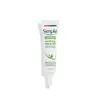What's inside
What's inside
 Key Ingredients
Key Ingredients

No key ingredients
 Benefits
Benefits

 Concerns
Concerns

 Ingredients Side-by-side
Ingredients Side-by-side

Water
Skin ConditioningPropanediol
SolventGlycerin
HumectantTetrahydroxypropyl Ethylenediamine
Caprylyl Glycol
EmollientPhenoxyethanol
PreservativeCarbomer
Emulsion StabilisingSaccharide Isomerate
HumectantCitric Acid
BufferingHydrolyzed Lupine Protein
Skin ConditioningDisodium EDTA
Medicago Sativa Seed Extract
Skin ConditioningSodium Chloride
MaskingPotassium Chloride
Sodium Citrate
BufferingEthylhexylglycerin
Skin ConditioningWater
Skin ConditioningPEG-100 Stearate
Glyceryl Stearate
EmollientButyrospermum Parkii Butter
Skin ConditioningCyclopentasiloxane
EmollientBisabolol
MaskingC13-14 Isoparaffin
EmollientCaprylyl Glycol
EmollientCetearyl Alcohol
EmollientLaureth-7
EmulsifyingPanthenol
Skin ConditioningPantolactone
HumectantPhenoxyethanol
PreservativePolyacrylamide
Simmondsia Chinensis Seed Oil
EmollientSodium Hyaluronate
HumectantTocopheryl Acetate
Antioxidant
 Reviews
Reviews

Ingredients Explained
These ingredients are found in both products.
Ingredients higher up in an ingredient list are typically present in a larger amount.
Caprylyl Glycol is a humectant and emollient, meaning it attracts and preserves moisture.
It is a common ingredient in many products, especially those designed to hydrate skin. The primary benefits are retaining moisture, skin softening, and promoting a healthy skin barrier.
Though Caprylyl Glycol is an alcohol derived from fatty acids, it is not the kind that can dry out skin.
This ingredient is also used as a preservative to extend the life of products. It has slight antimicrobial properties.
Learn more about Caprylyl GlycolPhenoxyethanol is a preservative that has germicide, antimicrobial, and aromatic properties. Studies show that phenoxyethanol can prevent microbial growth. By itself, it has a scent that is similar to that of a rose.
It's often used in formulations along with Caprylyl Glycol to preserve the shelf life of products.
Water. It's the most common cosmetic ingredient of all. You'll usually see it at the top of ingredient lists, meaning that it makes up the largest part of the product.
So why is it so popular? Water most often acts as a solvent - this means that it helps dissolve other ingredients into the formulation.
You'll also recognize water as that liquid we all need to stay alive. If you see this, drink a glass of water. Stay hydrated!
Learn more about Water